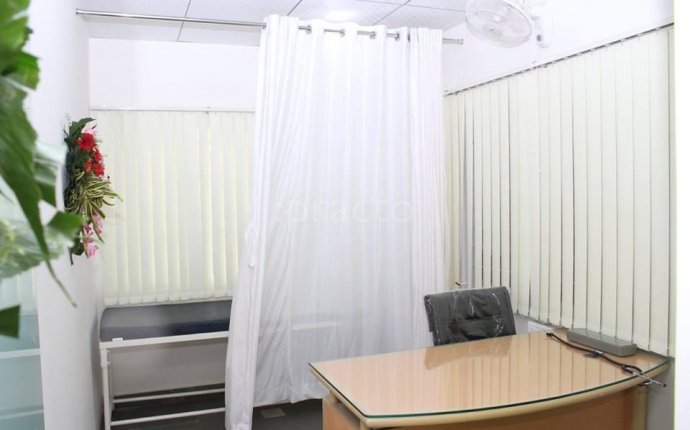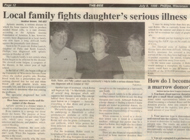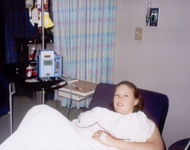
Aplastic anemia Treatment in Ayurveda
 I was diagnosed with Aplastic Anemia in 1997. [Aplastic Anemia is a non-contagious disease that occurs when the bone marrow stops making enough healthy blood cells for the body’s needs.] I am now in complete remission, and I’m pretty confident it won’t come back to challenge me — because it knows it won’t win — it has made me too strong.
I was diagnosed with Aplastic Anemia in 1997. [Aplastic Anemia is a non-contagious disease that occurs when the bone marrow stops making enough healthy blood cells for the body’s needs.] I am now in complete remission, and I’m pretty confident it won’t come back to challenge me — because it knows it won’t win — it has made me too strong.
Aplastic Anemia has shaped my life, and I am now constantly striving for new adventure, and I don’t disregard any new idea that pops into my crazy little head — I’m willing to give it a shot. Because, well, why the heck not!? We’ve got this one life, might as well use it to the fullest!
“YOU MUST BE MISTAKEN…” :: As I think back to high school, I remember a few things that may have been early signs of Aplastic Anemia, but I had no idea at the time. I was tired a lot, but so was everyone else my age. I was 17, and I was up late doing homework, spending weekends with friends, and not getting much sleep, so my fatigue seemed normal. I also remember being turned down to donate blood my senior year because my red blood count was too low – they informed me that I was anemic and that I should start taking iron supplements. These may have been symptoms of a disease I didn’t know I had yet, and they may not have. Truth is, I don’t remember ever having “symptoms”…
After high school I went on to college at the University of Wisconsin – Stevens Point, where I majored in art with an emphasis in graphic design. I remember visiting the school clinic for a checkup, and the nurse took a finger-prick blood test. I was soon called back in for two more tests, both of which I assumed were standard procedures.
Then on one normal, routine day, I sat in line at the clinic to pick up a prescription. A doctor walked up behind me and asked, “Are you Robin Laatsch?” I responded with a “yes, ” and he proceeded to tell me that he needed to speak to me in his office. I remember feeling like I was in school, being asked to report to the principal’s office! I said to him, “Oh, you must be mistaken. I’m just here to get a prescription.” But he insisted, so I got up and followed him to his office. On his desk was the Physician’s Desk Reference (a huge, intimidating book), and it was opened to a particular page.
 THE DIAGNOSIS :: He went on to tell me that from my last few blood tests, he’d noticed a pattern. My blood counts were steadily dropping. He pointed to a page in the book on his desk and said, “I think this might be Aplastic Anemia, and you need to see a specialist immediately.” I don’t remember being scared or freaked out or anything. I just remember thinking, “okay, I’ll just do what this crazy doctor-guy says I should.” Later on I realized that he may have saved my life. If he hadn’t noticed the pattern, I don’t know how I would’ve found out or what may have happened.
THE DIAGNOSIS :: He went on to tell me that from my last few blood tests, he’d noticed a pattern. My blood counts were steadily dropping. He pointed to a page in the book on his desk and said, “I think this might be Aplastic Anemia, and you need to see a specialist immediately.” I don’t remember being scared or freaked out or anything. I just remember thinking, “okay, I’ll just do what this crazy doctor-guy says I should.” Later on I realized that he may have saved my life. If he hadn’t noticed the pattern, I don’t know how I would’ve found out or what may have happened.
So I called my parents right from his office phone and told them I needed to see a specialist. It didn’t feel like a big deal to me at the time, so I was probably pretty calm. We set up an appointment with a hematologist at Marshfield Clinic in Marshfield, Wisconsin.
VISITING THE HEMATOLOGIST :: The hematologist in Marshfield looked at my low blood counts and requested a bone marrow biopsy right away. They gave me some local anesthetic, then drilled into the back of my pelvic bone and took a small sample to test. The test confirmed that I had Aplastic Anemia.
We were told that sometimes this disease can turn itself around when the patient is younger (I was 18), so we were instructed to go home and continue our normal daily lives. I was to have my blood drawn often and have the nurse send the results directly to Marshfield for them to keep an eye on them. After six months of this routine, I had a follow-up appointment in Marshfield. We were introduced to a new doctor, Dr. Lawrence Clouse. His honesty and straightforwardness connected us immediately. He brought us into a private conference room and told us straight out that the situation had worsened. My counts were so low I was going to need transfusions—and I needed treatment immediately.














